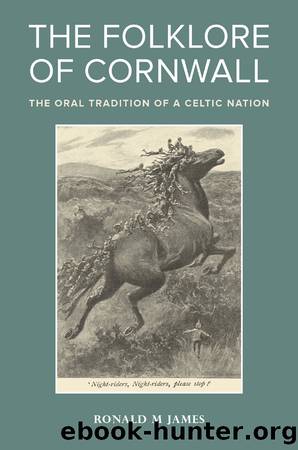The Folklore of Cornwall by Ronald M. James

Author:Ronald M. James [James, Ronald M.]
Language: eng
Format: epub
Tags: History, General, Social Science, Customs & Traditions, Folklore & Mythology, Popular Culture, Sociology
ISBN: 9780859894999
Google: nvfADwAAQBAJ
Publisher: University of Exeter Press
Published: 2019-04-30T02:43:07+00:00
Legends of the Dead
The Cornish story of âThe Spectre Bridegroomâ draws on two ideas that are worldwide. The first is the belief that the dead occasionally walk among the living. The second is that sometimes supernatural beings have love affairs with people, usually with a tragic result. Both motifs are international and in turn have inspired a great deal of literature. Because the boundary between folklore and the written word is porous, each has influenced the other.22
Tales of ghosts permeate literature and have done so for thousands of years, with examples appearing in Homeric poetry, the Old Testament, continental medieval literature and Icelandic sagas. Counterparts in oral tradition are so widespread as to suggest that this was the case before the invention of writing. Although stories of hauntings are ubiquitous, it is generally accepted that most of the dead rest in peace. And yet, some do not. The Finnish scholar, Juha Pentikäinen, considers a belief in the dead who trouble the living because they lack an acceptable status in death. This concept applies nicely to the situation of âThe Dead Bridegroom Carries off His Brideâ, an observation of Uà ÃgaÃn and OâConnor.23 In this case, the ghost cannot rest because of the intensity of the love he and his betrothed shared in life. In addition, many stories underscore the excessive nature of their secret vows and the fact that the lovers often employ magic to bind themselves together. There is an implicit warning here that one should not use supernatural means beyond Christian prayer and ceremony to affect outcomes.
Numerous examples of ill-fated, supernatural romances come to mind in European literature. These sorts of liaisons have inspired medieval stories of sexual encounters between elves and people, ballets featuring seductive swan-women, and modern novels and films with rakish vampires. The popularity of broadsheet ballads describing the âSpectre Bridegroomâ draws on this same fascination with what happens when people cross the barrier that separates the natural from the supernatural, all in the name of love.
For what appears to be the earliest printed expression of this specific motif, one needs to reach back to eleventh-century Scandinavian literature. The medieval collection of verse, The Poetic Edda, includes the âSecond Lay of Helgi the Hunding-Slayerâ. This describes how Helgi, a dead hero, returns from the grave on a horse to beckon his beloved Sigrún to him for one last night of conjugal bliss. The document hints at the age of the motif, but it also suggests that initially, the story may have played out differently: Sigrún willingly enters Helgiâs burial mound to lie with him. The poem subsequently relates that the heroine âlived but a short while longer, for grief and sorrowâ. With this, the medieval text concurs with the conclusion of its more recent counterpart.24 This example suggests that for pre-Christian society, crossing the line into the realm of the dead in the name of romance could be seen as heroic. Nineteenth-century expressions of the story generally assert that no living person would want to enter the grave, even if it were the last resting place of a lover.
Download
This site does not store any files on its server. We only index and link to content provided by other sites. Please contact the content providers to delete copyright contents if any and email us, we'll remove relevant links or contents immediately.
Cecilia; Or, Memoirs of an Heiress — Volume 1 by Fanny Burney(32021)
Cecilia; Or, Memoirs of an Heiress — Volume 3 by Fanny Burney(31436)
Cecilia; Or, Memoirs of an Heiress — Volume 2 by Fanny Burney(31380)
The Great Music City by Andrea Baker(30637)
We're Going to Need More Wine by Gabrielle Union(18604)
All the Missing Girls by Megan Miranda(14575)
Pimp by Iceberg Slim(13715)
Bombshells: Glamour Girls of a Lifetime by Sullivan Steve(13663)
Fifty Shades Freed by E L James(12885)
Talking to Strangers by Malcolm Gladwell(12812)
Norse Mythology by Gaiman Neil(12778)
For the Love of Europe by Rick Steves(11330)
Crazy Rich Asians by Kevin Kwan(8859)
Mindhunter: Inside the FBI's Elite Serial Crime Unit by John E. Douglas & Mark Olshaker(8662)
The Lost Art of Listening by Michael P. Nichols(7124)
Enlightenment Now: The Case for Reason, Science, Humanism, and Progress by Steven Pinker(6851)
The Four Agreements by Don Miguel Ruiz(6281)
Bad Blood by John Carreyrou(6251)
Weapons of Math Destruction by Cathy O'Neil(5798)
